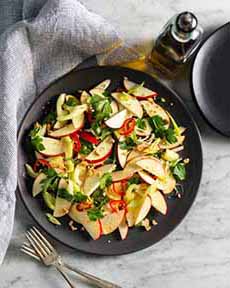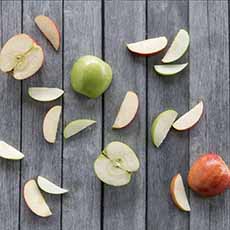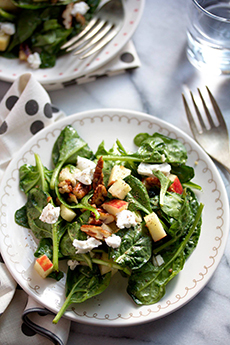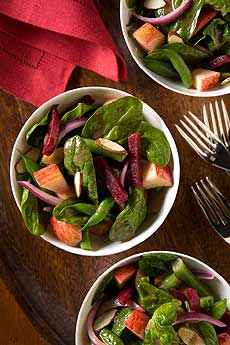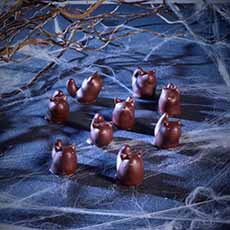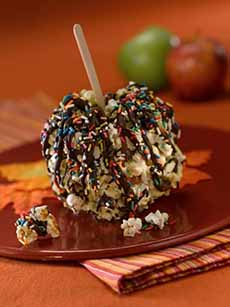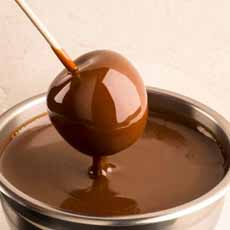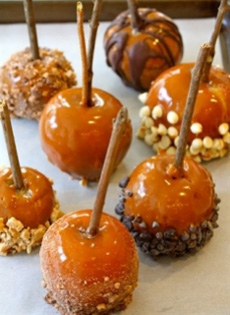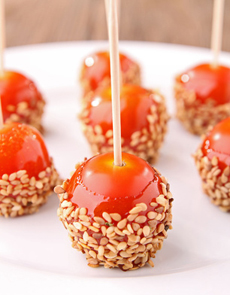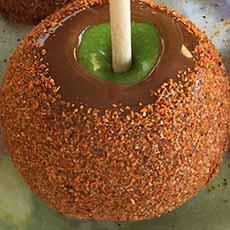|
October 20th is National Brandied Fruit Day. Make it now and enjoy it over the holidays…or tomorrow! Brandied fruit is something you can overnight, or “cure” for one or two months to enjoy a more profound marinated flavor. We’ll start by enticing you with the many ways you can use brandied fruits; then go on to a recipe and the history of brandied fruits and brandy.
USES FOR BRANDIED FRUIT
On ice cream or sorbet.
On angel food cake, pound cake or iced cakes.
In meringue shells (pavlova). See photo #3.
Atop custard, pudding or bread pudding.
As a side with grilled fish, chicken, lamb and pork.
On French toast or waffles, especially dessert waffles with fudge sauce.
Spooned over crêpes and sweet omelets.
Mixed into vanilla yogurt for a fruit-and-brandy yogurt or a dessert topping/sauce.
For Cherries Jubilee, a recipe made with either brandy or Kirschwasser (cherry brandy).
Drain it for a topping or condiment, use the fruit and all its liquid for a dessert sauce.
It’s an easy and festive way to give food pizzazz.
The history of brandied fruit is below, but first, an easy recipe.
And if you don’t find what you need in this article, check out our earlier article on brandied fruits.
RECIPE: BRANDIED FRUITS
A note about the fruits: The time to make brandied fruit is when you have ripe fruits in season. There’s less choice in the colder weather, but apples, citrus, grapes, and strawberries are readily available (see photo # 6).
Don’t use “mushy” fruits like bananas or kiwis. But you can add some dried fruits into the mix: dried apricots, cherries, raisins, etc.
You can also brandy peach halves, which make a luscious summer dessert with crème fraîche or ice cream. You can even flambée brandied fruit. But start smaller, with berries and sliced fruits.
In theory, you could use frozen fruits. We haven’t tried it, but we haven’t found anything that warns against it. It’s a nice experiment—we’ll have to try it.
About the brandy: Don’t use an expensive bottle, unless you’re so well-to-do that you won’t notice, or you’re trying to impress some connoisseur guests. VSOP Cognac* is fine. Don’t use cheap brandy because the cheapness will flavor your fruit.
Quick Marinade Overnight: We mostly marinated the fruits overnight. They can be used right away, or allowed to marinate some more. The recipe below marinates the fruit for 30 days or more.
Ingredients For 8 Pint Jars
This recipe uses a lot of sugar! We use 1/6 cup of sugar per cup of fruit. That would be 1-1/2 cups of sugar for the 9 cups of fruit.
Try a batch with half the amount. You can always taste during the curing process and add more. Also add more brandy if it no longer covers all of the fruit.
9 cups fresh fruits: whole berries and/or diced fruits of choice, washed (peeling is not necessary)
5 cups of sugar
5 cups light brown sugar, firmly packed
4 cups brandy
Preparation
1. COMBINE in a very large bowl the fruits and sugars, tossing well. Cover and let macerate for 1 hour, tossing every 15 minutes.
2. DIVIDE the fruit among 8 sterilized pint jars. Pour in the brandy, making sure the fruit is totally covered. Cap the jars and store in a cool place for at least one month; 2 months is fine.
Since the brandied fruit will only improve with age, let the flavors develop for at least a month. Check out this step by step video from New Deal Distillery. (We used their brandy to make our last batch.)
THE HISTORY OF BRANDIED FRUIT & THE HISTORY OF BRANDY
Man has macerated fruit with wine for thousands of years. It was a way to turn overripe fruit or fruit that lacked sweetness into something more pleasant.
But wine itself is not a preservative; it oxidizes. So the fruit was tasty for the day, but in order to put up fruit for the off-season, alcoholic spirits were needed.
The distillation of alcoholic spirits was discovered in the eighth century (the history of distillation). But it took longer to “invent” brandy.
Brandy is a spirit produced by distilling wine or a fermented fruit mash. The name comes from the Dutch brandewijn, burnt wine, which refers to the application of heat in the distillation process.
Commercial distillation of brandy from wine originated in the 16th century. According to one story, a Dutch wine merchant realized he could import more wine per ship by concentrating the wine for shipment. He heated the wine to evaporate the water, which he could add back in when the barrels reached Holland.
But surprise: The concentrated wine was deemed to be delicious! No dilution was desired. And that’s how the distillation of wine into brandy was [allegedly] born.
Most brandy is 80 proof (40% alcohol/volume) and has been enjoyed ever since then as a quaff and in cocktails.
Standard brandy is made from wine grapes. But it can be made with other fruits, including apples, apricots, and cherries. These are classified as “flavored brandies” or eau-de-vie.
Popular eaux-de-vie include apple (pomme), apricot (blume marillen), cherry (kirsch), peach (pêche), pear (Poire Williams), raspberry (framboise) and yellow plum (mirabelle).
The finest brandy is Cognac (CONE-yak), produced in the Cognac region of France.
Second place foes to Armagnac (ar-mon-YAK), produced in the Armagnac region in Gascony, southwest France. It is distilled from a different blend of grapes than Cognac. And it is distilled using column stills, rather than the pot stills used in Cognac.
Beyond drinking it, brandy has been used in cooking since the beginning: not just for short-term marinating as with the brandied fruit, but for long-term food preservation.
In addition, is used by the finest chefs as well as home cooks. Just some of the main uses:
To flambé desserts and mains. Baked Alaska, Bananas Foster, Cherries Jubilee, Christmas Pudding, Crêpes Suzette, Steak Diane, and more.
In cakes and cheesecakes. We love Grand Marnier, orange-flavored brandy, for baking and sweet sauces).
In other desserts. Mousse, pot de crème, puddings, sticky toffee pudding, and dessert sauces all deserve a bit of brandy.
In savory sauces for meats and seafood. Brandy is a must in Lobster Newburg and in Steak au Poivre). It’s often used in braising and to deglaze the pan for a pan sauce.
In other foods: Add a spoonful along with the butter in mashed potatoes, and try it as a soup garnish (dribble some on the top).
WHERE IS BRANDY PRODUCED?
Most wine-producing countries also make brandy:
France: Armagnac, Calvados, Cognac (from the Charente and Charente-Maritime départements of France, usually considered the finest of all brandies). The leftover grape pomace of most winemakers is distilled into an eau-de-vie called marc (pronounced MAR).
The sherry-producing centers of Spain and the port-producing centers of Portugal are also known for brandy.
Greece: Metaxa, sweetened and usually darkened with caramel, and ouzo, colorless and flavored with anise or licorice. American brandy, produced mainly in California, tends to be neutral and uniform in character.
Italy: Grappa, an unaged, sharp-tasting brandy.
Peru: Pisco, distilled from muscat wines. Brandies distilled from grape pomace, or marc, the material remaining in the winepress after grape pressing, include the French eau-de-vie de
Portugal: Macieira, distilled from Port, a technique created by a Portuguese winemaker who studied in the French region of Cognac.
Spain: Brandy de Jerez (sherry-distilled brandy).
U.S.A.: Apple brandy, applejack [source].
|
|
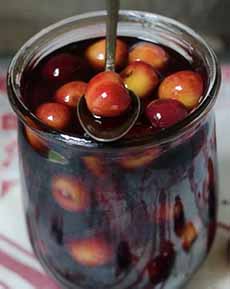
[1] Brandy cherries in season, and enjoy them for months. Check out this article (photo © Chowhound).
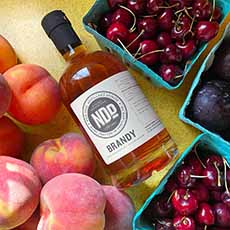
[2] Gather seasonal fruits and a bottle of good brandy (photo © New Deal Distillery).
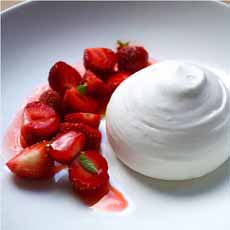
[3] A Pavlova comprises a baked meringue and fruit. Often the meringue is an individual or full-size bowl shape. But here, a domed meringue sits next to the fruit (photo © Vaucluse | NYC [permanently closed]).

[4] Make brandied cherries for the holidays. Here, you can use lots of sugar (photo © Ocean Spray).
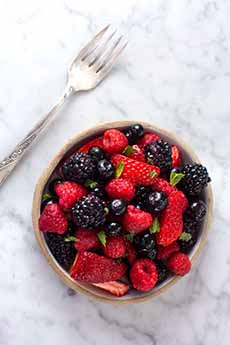
[5] We love to marinate berries overnight in Grand Marnier. They’re heavenly (photo © DeLallo).

[6] In the winter, strawberries and citrus do just fine (photo © Good Eggs).
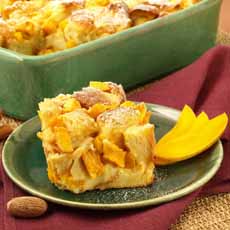
Use brandied fruit in baked goods, from cakes and pies to this brandied mango bread pudding recipe (photo © from Relish).

[8] Cherries Jubilee, created by Escoffier for Queen Victoria’s Golden Jubilee—50 years as Queen. Here’s the recipe (photo © Tiny New York Kitchen).

[9] Brandied fruit is delicious on ice cream or custard: a simple but elegant dessert (photo © Williams Sonoma).
|
________________
*Brandy & Cognac Difference: Both brandy and cognac wall into the category of grape brandy, distilled from white wine grapes. But cognac is a superior product. Here’s more about it.
†Some fruit brandies include framboise, distilled from raspberries in the Alsace region of France, and fraise, distilled from strawberries. Other fruit brandies include slivovitz, a plum brandy produced in various Balkan countries; barack palinka, an apricot brandy from Hungary; Kirschwasser, or kirsch, distilled from cherries, mainly in Alsace, Germany, and Switzerland; and the French plum wines, from Alsace and Lorraine, including mirabelle, made from a yellow plum, and quetsch, made from a blue plum.
|
